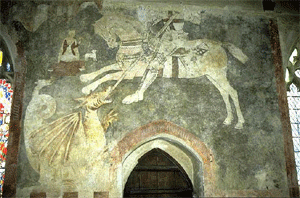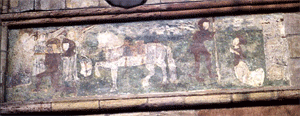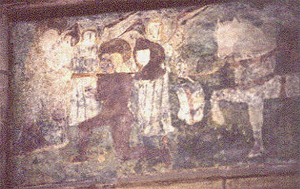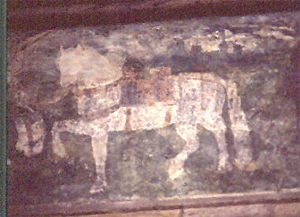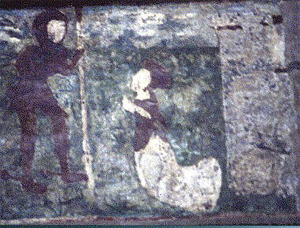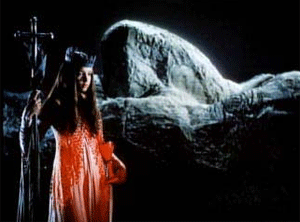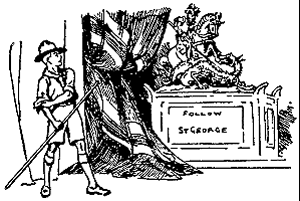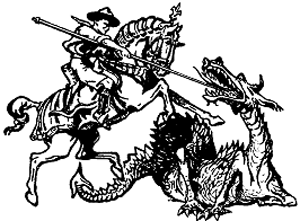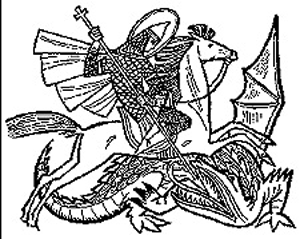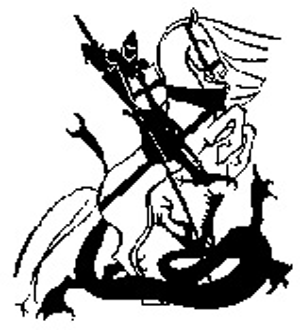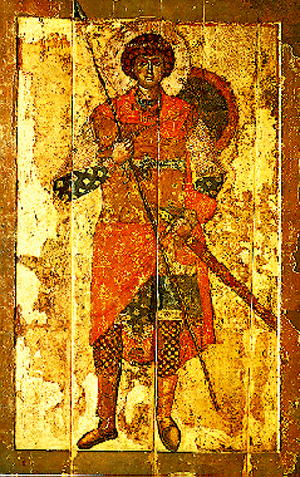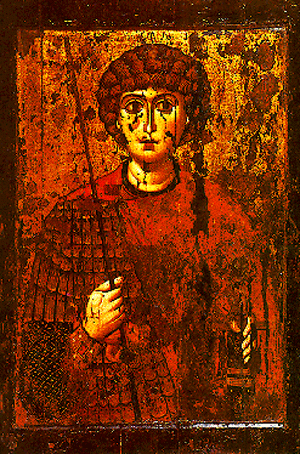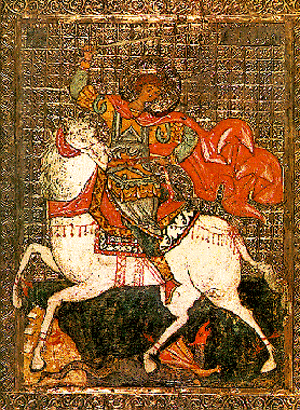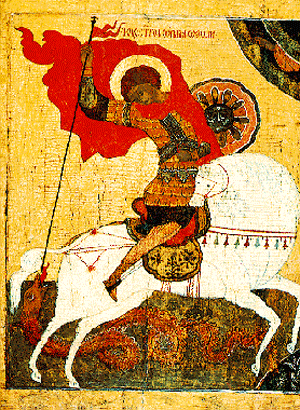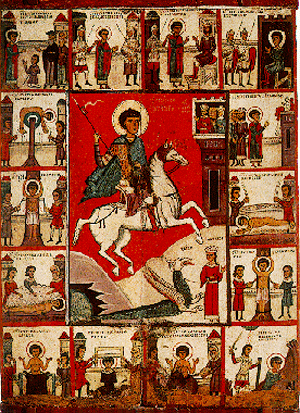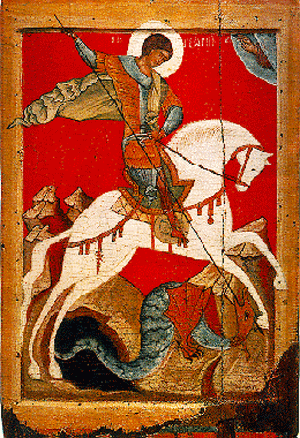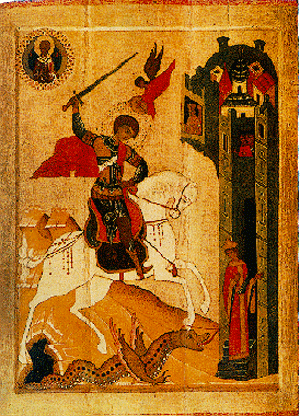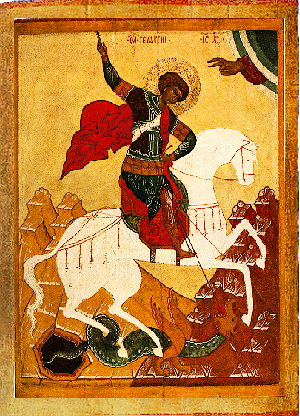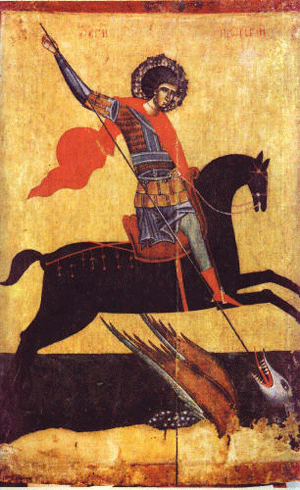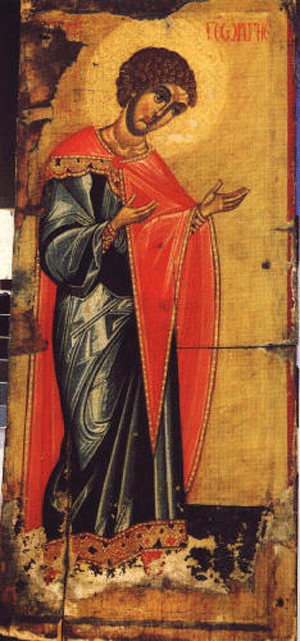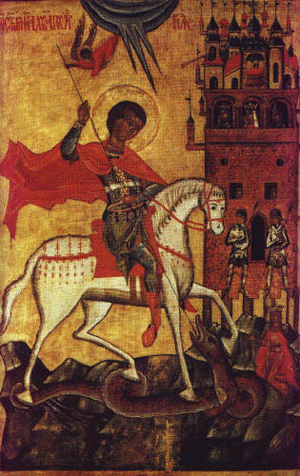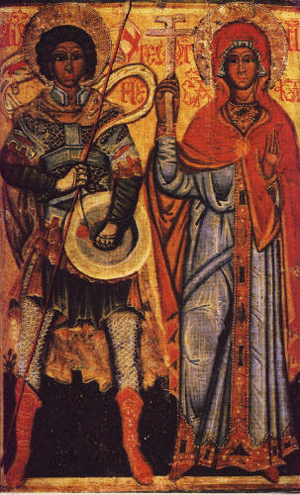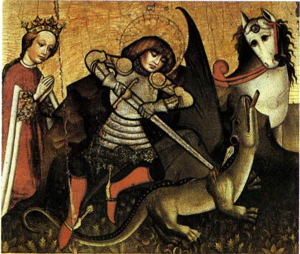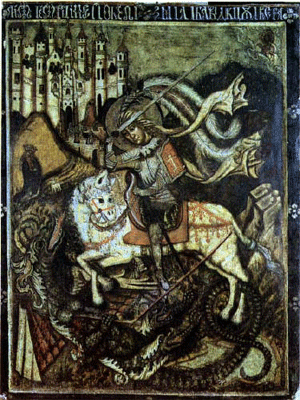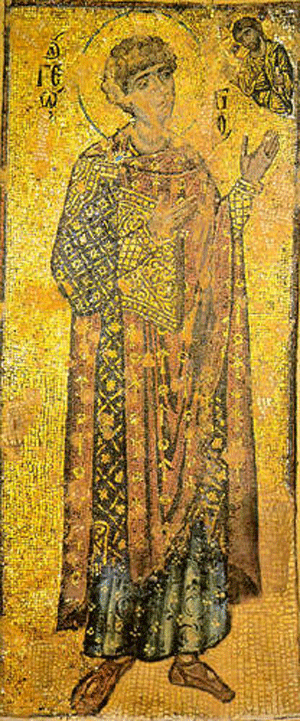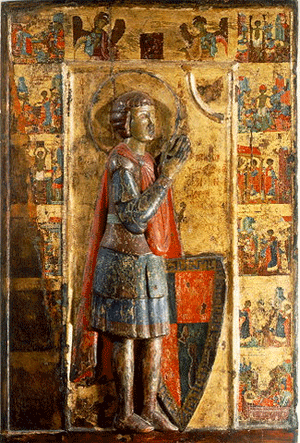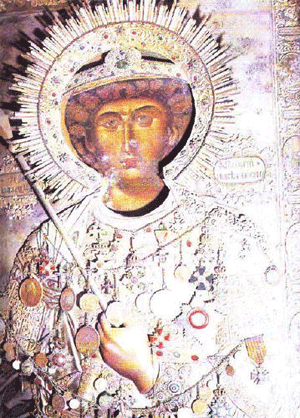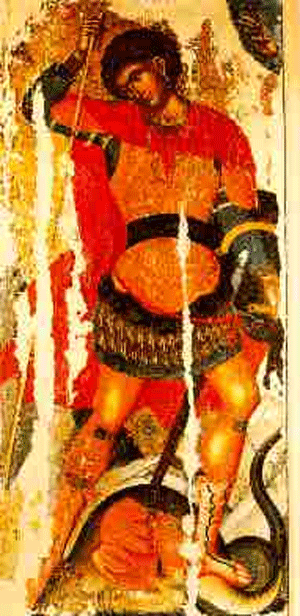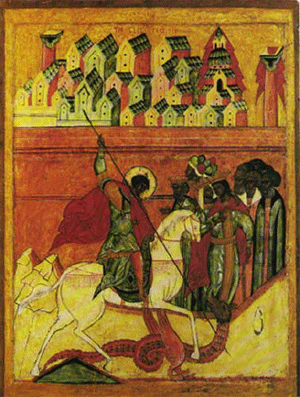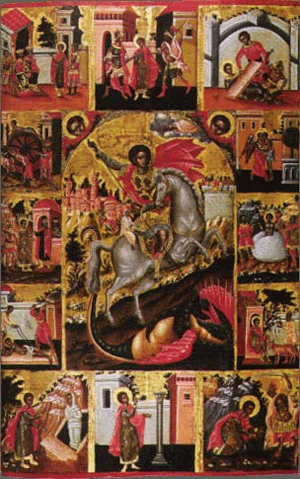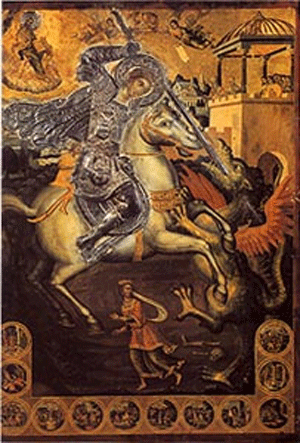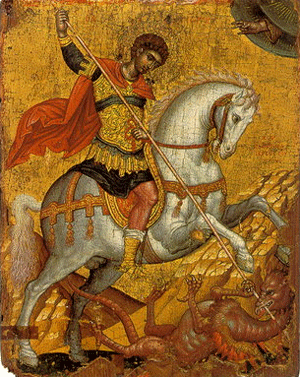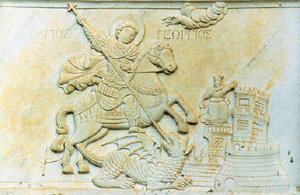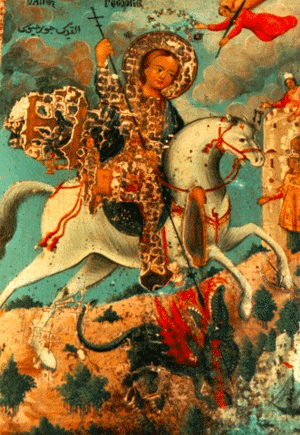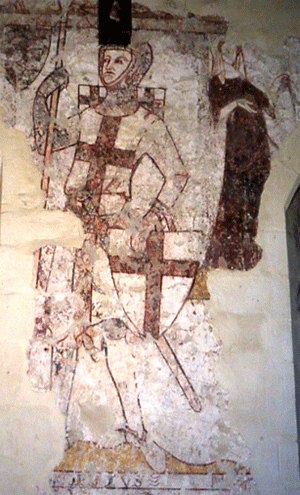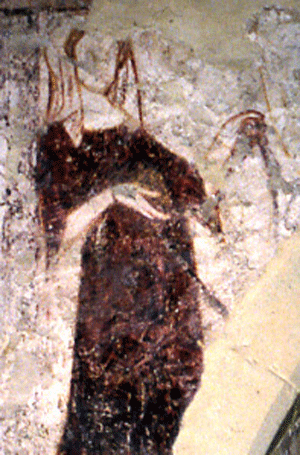by Michael Collins MA (Oxon) MPhil
Copyright ©1996, 1997, 1998 Britannia Internet Magazine.
NOTICE: THIS WORK MAY BE PROTECTED BY COPYRIGHT
YOU ARE REQUIRED TO READ THE COPYRIGHT NOTICE AT THIS LINK BEFORE YOU READ THE FOLLOWING WORK, THAT IS AVAILABLE SOLELY FOR PRIVATE STUDY, SCHOLARSHIP OR RESEARCH PURSUANT TO 17 U.S.C. SECTION 107 AND 108. IN THE EVENT THAT THE LIBRARY DETERMINES THAT UNLAWFUL COPYING OF THIS WORK HAS OCCURRED, THE LIBRARY HAS THE RIGHT TO BLOCK THE I.P. ADDRESS AT WHICH THE UNLAWFUL COPYING APPEARED TO HAVE OCCURRED. THANK YOU FOR RESPECTING THE RIGHTS OF COPYRIGHT OWNERS.
In this short essay compiled from secondary sources, I have identified three main themes:
1. the historical St George
2. the growth and influence of legends about him in England
3. the place of St George in English history, literature and institutions
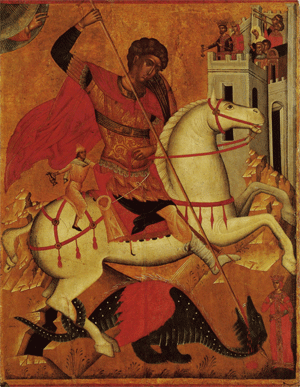
Because the themes are interrelated and affect each other, I present them chronologically. An essay on the theological considerations is planned as a separate, linked page.
St George is the patron saint of England and among the most famous of Christian figures. But of the man himself, nothing is certainly known. Our earliest source, Eusebius of Caesarea, writing c. 322, tells of a soldier of noble birth who was put to death under Diocletian at Nicomedia on 23 April, 303, but makes no mention of his name, his country or his place of burial. According to the apocryphal Acts of St George current in various versions in the Eastern Church from the fifth century, George held the rank of tribune in the Roman army and was beheaded by Diocletian for protesting against the Emperor's persecution of Christians. George rapidly became venerated throughout Christendom as an example of bravery in defence of the poor and the defenceless and of the Christian faith.
George was probably first made well known in England by Arculpus and Adamnan in the early eighth century. The Acts of St George, which recounted his visits to Caerleon and Glastonbury while on service in England, were translated into Anglo-Saxon. Among churches dedicated to St George was one at Doncaster in 1061. George was adopted as the patron saint of soldiers after he was said to have appeared to the Crusader army at the Battle of Antioch in 1098. Many similar stories were transmitted to the West by Crusaders who had heard them from Byzantine troops, and were circulated further by the troubadours. When Richard 1 was campaigning in Palestine in 1191-92 he put the army under the protection of St George.
Because of his widespread following, particularly in the Near East, and the many miracles attributed to him, George became universally recognized as a saint sometime after 900. Originally, veneration as a saint was authorized by local bishops but, after a number of scandals, the Popes began in the twelfth century to take control of the procedure and to systematize it. A lesser holiday in honour of St George, to be kept on 23 April, was declared by the Synod of Oxford in 1222; and St George had become acknowledged as Patron Saint of England by the end of the fourteenth century. In 1415, the year of Agincourt, Archbishop Chichele raised St George's Day to a great feast and ordered it to be observed like Christmas Day. In 1778 the holiday reverted to a simple day of devotion for English Catholics.
The banner of St George, the red cross of a martyr on a white background, was adopted for the uniform of English soldiers possibly in the reign of Richard 1, and later became the flag of England and the White Ensign of the Royal Navy. In a seal of Lyme Regis dating from 1284 a ship is depicted bearing a flag with a cross on a plain background. During Edward III's campaigns in France in 1345-49, pennants bearing the red cross on a white background were ordered for the king's ship and uniforms in the same style for the men at arms. When Richard II invaded Scotland in 1385, every man was ordered to wear 'a signe (sic) of the arms of St George', both before and behind, whilst death was threatened against any of the enemy's soldiers 'who do bear the same crosse or token of Saint George, even if they be prisoners'.
The fame of St George throughout Europe was greatly increased by the publication of the Legenda Sanctorum (Readings on the Saints), later known as the Legenda Aurea (The Golden Legend) by James of Voragine in 1265. The name 'golden legend' does not refer to St George but to the whole collection of stories, which were said to be worth their weight in gold. It was this book which popularized the legend of George and the Dragon. The legend may have been particularly well received in England because of a similar legend in Anglo-Saxon literature. St George became a stock figure in the secular miracle plays derived from pagan sources which continued to be performed at the beginning of spring. The origin of the legend remains obscure. It is first recorded in the late sixth century and may have been an allegory of the persecution of Diocletian, who was sometimes referred to as 'the dragon' in ancient texts. The story may also be a christianized version of the Greek legend of Perseus, who was said to have rescued the virgin Andromeda from a sea monster at Arsuf or Jaffa, near Lydda (Diospolis), where the cult of St George grew up around the site of his supposed tomb.
In 1348, George was adopted by Edward III as principal Patron of his new order of chivalry, the Knights of the Garter. Some believe that the Order took its name from a pendant badge or jewel traditionally shown in depictions of Saint George. The insignia of the Order include a Collar and Badge Appendant, known as the George. The badge is of gold and presents a richly enamelled representation of St George on horseback slaying the dragon. A second medal, the Lesser George, also depicting George and the dragon, is worn attached to the Sash. The objective of the Order was probably to focus the efforts of England on further Crusades to reconquer the Holy Land. The earliest records of the Order of the Garter were destroyed by fire, but it is believed that either in 1348 or in 1344 Edward proclaimed St George Patron Saint of England. Although the cult of St George was suppressed in England at the Reformation, St George's Chapel, Windsor, completed in stages from 1483 to 1528, has remained the official seat of the Order, where its chapters assemble. The Monarch and the Prince of Wales are always members, together with 24 others and 26 Knights or Ladies Companion.
Much later, in 1818, the Prince Regent, later George IV, created the Most Distinguished Order of St Michael and St George to recognize exemplary service in the diplomatic field. The Order was founded to commemorate the British protectorate of the Ionian islands and Malta, which had begun in 1814. Originally membership was limited to inhabitants of the islands and to Britons who had served locally. In 1879 membership was widened to include foreigners who had performed distinguished service in Commonwealth countries. The Order was reorganized by William IV into three classes: Knight Grand Cross (GCMG); Knight Commander (KCMG); and Companion (CMG). Nowadays there are women members of each class with the title 'Dame'. The medal of the Order shows St George and the Dragon on one side, and St Michael confronting the Devil on the other with the inscription,'auspicium melioris aevi' ('augury of a better age'). The Chapel of the Order is St Paul's Cathedral.
Saint George is a leading character in one of the greatest poems in the English language, Spencer's Faerie Queene (1590 and 1596). St George appears in Book 1 as the Redcrosse (sic) Knight of Holiness, protector of the Virgin. In this guise he may also be seen as the Anglican church upholding the monarchy of Elizabeth I:
But on his breast a bloody Cross he bore
The dear remembrance of his dying Lord,
For whose sweet sake that glorious badge we wore
And dead (as living) ever he adored.
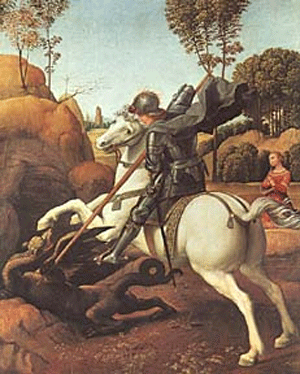
The legend of St George and the dragon took on a new lease of life during the Counter Reformation. The discoveries in Africa, India and the Americas, in areas which maps had previously shown as populated by dragons, presented vast new fields for Church missionary endeavour, and St George was once again invoked as an example of danger faced and overcome for the good of the Church. Meanwhile, the Protestant author, John Bunyan (1628-88), recalled the story of George and the Dragon in the account of the fight between Christian and Apollyon in Pilgrim's Progress (1679 and 1684).
The cult of St George was ridiculed by Erasmus after his visit (sometime between 1511 and 1513) to the saint's shrine at Canterbury, where the supposed arm of George attracted a large pilgrim traffic. Edmund Gibbon claimed that St George was originally George of Cappadocia, the Arian opponent of St Athanasius, but this theory, says Gibbon's nineteenth-century editor, J.B.Bury, 'has nothing to be said for it'. Research which established what little we actually know about the historical George was carried out around the turn of the century by the Bollandists, a scholarly society within the Jesuits. On the evidence of fourth century inscriptions found in Syria, one dating from c346, and the testimony of the pilgrim Theodosius, who visited Lydda in 530 and is the first to mention the tomb of St George, they concluded that George had indeed actually existed.
In more modern times, St George was chosen by Baden-Powell, its founder, to be patron of the Scouting Movement, and on St George's Day, scouts are bidden to remember their Promise and the Scout Law. Baden-Powell recounted in Scouting for Boys that the Knights of the Round Table 'had as their patron saint St George because he was the only one of all the saints who was a horseman. He is the patron saint of cavalry, from which the word chivalry is derived'.
In 1940, when the civilian population of Britain was subjected to mass bombing by the Luftwaffe, King George V1 instituted the George Cross for 'acts of the greatest heroism or of the most conspicuous courage in circumstances of extreme danger'. The award, which is second only to the Victoria Cross, the highest military decoration, is usually given to civilians and can be given posthumously. The award consists of a silver cross. On one side is depicted St George slaying the dragon, with the inscription,'For Gallantry'; on the other appear the name of the holder and the date of the award. For lesser, but still outstanding acts of courage, the King created the George Medal. This also is a silver cross, with on one side the reigning monarch and on the other St George slaying the dragon. The island of Malta was awarded the George Cross for its heroism in resisting attack during World War 11.
Some confusion has arisen from the revision of its Calendar of Saints by the Roman Catholic Church in 1969. Saints have long been honoured with different degrees of solemnity. What the Catholic Church did was to downgrade the recollection of St George to the lowest category, commemoration, an optional memorial for local observance. The Church did not abolish St George. Indeed, it maintains a fine Cathedral named for him, opposite the Imperial War Museum in London.
The reason the Church now simply commemorates St George is that, although he certainly existed, so little is definitely known about him. Most of the legends about George are apochryphal and indeed incredible. The Church has never officially held that these legends are literally true, but made use of them to illustrate some of its teachings in times when people were more comfortable with such materials. As early as 496, Pope Gelasius in De libris recipiendis includes George among those saints 'whose names are rightly reverenced among us, but whose actions are known only to God'. The virtues associated with St George, such as courage, honour and fortitude in defence of the Christian faith, indeed remain as important as ever. St George is also, of course, venerated in the Church of England, by the Orthodox churches and by the Churches of the Near East and Ethiopia. The supposed tomb of St George can still be seen at Lod, south-east of Tel-Aviv; and a convent in Cairo preserves personal objects which are believed to have belonged to George.
St George is still venerated in a large number of places, by followers of particular occupations and sufferers from certain diseases. George is the patron saint of Aragon, Catalonia, Georgia, Lithuania, Palestine, Portugal, Germany and Greece; and of Moscow, Istanbul, Genoa and Venice (second to St Mark). He is patron of soldiers, cavalry and chivalry; of farmers and field workers, Boy Scouts and butchers; of horses, riders and saddlers; and of sufferers from leprosy, plague and syphilis. He is particularly the patron saint of archers, which gives special point to these famous lines from Shakespeare's Henry V, Act 3, Scene 1, l. 31:
'I see you stand like greyhounds in the slips,
Straining upon the start. The game's afoot:
Follow your spirit; and, upon this charge
Cry God for Harry, England and St George!'
Indirectly, the spirit of George the soldier saint played a part in modern English history when Sir Laurence Olivier's film of Henry V was issued in 1944 as an encouragement to our armies fighting for the liberation of France.
H.Delehaye, Les legendes grecques des saints militaires, Paris 1909
I.H.Elder, George of Lydda, 1949
E. Hoode, Guide to the Holy Land, Jerusalem 1962
G.J.Marcus, Saint George of England, 1939
Jacobus de Voragine, The Golden Legend : Readings on the Saints, Tr. William Granger Ryan, 2 vols (Princeton: Princeton University Press, 1993)

